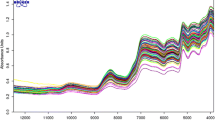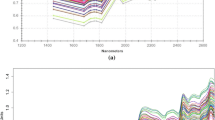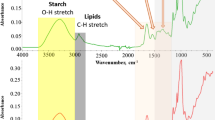Abstract
Fourier transform infrared spectroscopy (FTNIR) is an excellent mode for evaluation of grain-quality attributes. It enables the nonperturbative molecular information to be diagnosed and allows the explication of images of grains by the passage of the spectral data through an array of computational algorithms. The images are contrived from fingerprint spectra so the conception is that the reflection can conceal the status of the analyzed sample. Rhyzopertha dominica F.- and Sitophilus oryzae-infested and fresh rice grains analyzed with FTNIR within a range of 12,000–4000 cm−1 were proffered to mathematical processing. Partial least squares regression (PLSR) was used for the estimation of physicochemical parameters of rice grains. Outstanding predictive results were acquired denoting that infested rice grains could be convincingly quantified. The coefficient of correlation, root mean square error of validation, and cross validation for the FTNIR model developed to quantify the quality attribute changes with infestation in rice grains were in the range of 99.85–99.01% (R2), 0.2–1.14% (RMSEE), and 0.3–1.25% (RMSECV). Excellent prediction results of various physico-chemical attributes were obtained for rice grains indicating the fresh and infested samples can be uniquely identified. Also, a paired t test was performed to compare the analytical methods with FTNIR-developed method; no significant difference was found (tcal 0.025 < tcri 2.12; α = 0.05, RPD > 6) between the two methods. Thus, the results further confirmed the developed FTNIR system to be inherently rapid, clean, and capable of preventing hazardous chemicals which originates from traditional analytical processes and has the potential for monitoring and sorting of rice grains.




Similar content being viewed by others
References
Agelet, L. E., & Hurburgh Jr., C. R. (2010). A tutorial on near infrared spectroscopy and its calibration. Critical Reviews in Analytical Chemistry, 40(4), 246–260. https://doi.org/10.1080/10408347.2010.515468.
AOAC. (2000). Official methods of analysis of AOAC International (17th ed.). Gaithersburg: AOAC.
Azizian, H., & Kramer, J. K. (2005). A rapid method for the quantification of fatty acids in fats and oils with emphasis on trans fatty acids using Fourier transform near infrared spectroscopy (FT-NIR). Lipids, 40(8), 855–867. https://doi.org/10.1007/s11745-005-1448-3.
Baker, J. E., Dowell, F. E., & Throne, J. E. (1999). Detection of parasitized rice weevils in wheat kernels with near-infrared spectroscopy. Biological Control, 16(1), 88–90. https://doi.org/10.1006/bcon.1999.0733.
Berardo, N., Pisacane, V., Battilani, P., Scandolara, A., Pietri, A., & Marocco, A. (2005). Rapid detection of kernel rots and mycotoxins in maize by near-infrared reflectance spectroscopy. Journal of Agricultural and Food Chemistry, 53(21), 8128–8134. https://doi.org/10.1021/jf0512297.
Brauteseth, E. M. (2009). The mutagenesis of Sorghum bicolour (L.) Moench towards improved nutrition and agronomic performance. Ph.D. thesis, School of Agricultural Sciences and Agribusiness, University of KwaZulu-Natal.
Chen, H., Ai, W., Feng, Q., Jia, Z., & Song, Q. (2014). FT-NIR spectroscopy and Whittaker smoother applied to joint analysis of duel-components for corn. Spectrochimica Acta Part A: Molecular and Biomolecular Spectroscopy, 118, 752–759. https://doi.org/10.1016/j.saa.2013.09.065.
Chitra, J., Ghosh, M., & Mishra, H. N. (2017). Rapid quantification of cholesterol in dairy powders using Fourier transform near infrared spectroscopy and chemometrics. Food Control, 78, 342–349. https://doi.org/10.1016/j.foodcont.2016.10.008.
Cozzolino, D. (2012). Recent trends on the use of infrared spectroscopy to trace and authenticate natural and agricultural food products. Applied Spectroscopy Reviews, 47(7), 518–530. https://doi.org/10.1080/05704928.2012.667858.
Egidio, D., Olivieri, P., Woodcock, T., & Downey, G. (2010). Confirmation of brand identity in foods by near infrared transflectance spectroscopy using classification and class-modeling chemometric techniques—the example of a Belgian beer. Food Research International, 44, 544–549.
Elizabeth, B. M., Dowell, F. E., Baker, J. E. & Throne, J. E. (2002).Detecting single wheat kernels containing live or dead insects using near infrared reflectance spectroscopy. ASAE Paper No. 023067. Chicago, IL: ASAE.
Esteban-Diez, I., Gonzalez-saiz, J. M., & Pizarro, C. (2004). An evaluation of orthogonal signal correction methods for the characterization of Arabica and robusta coffee varieties by NIRS. Analytica Chimica Acta, 514(1), 57–67. https://doi.org/10.1016/j.aca.2004.03.022.
Ferreira, D. S., Pallone, J. A. L., & Poppi, R. J. (2013). Fourier transform near-infrared spectroscopy (FT-NIRS) application to estimate Brazilian soybean Glycine max (L.) Merril composition. Food Research International, 51(1), 53–58. https://doi.org/10.1016/j.foodres.2012.09.015.
Ferreira, D. S., Galão, O. F., Pallone, J. A. L., & Poppi, R. J. (2014). Comparison an application of near-infrared (NIR) and mid-infrared (MIR) spectroscopy for determination of quality parameters in soybean samples. Food Control, 35(1), 227–232. https://doi.org/10.1016/j.foodcont.2013.07.010.
Grassi, S., Amigo, J. M., Lyndgaard, C. B., Foschino, R., & Casiraghi, E. (2014). Beer fermentation: monitoring of process parameters by FT-NIR and multivariate data analysis. Food Chemistry, 155(1), 279–286. https://doi.org/10.1016/j.foodchem.2014.01.060.
Jan, S., Rafiq, S. I., & Saxena, D. C. (2015). Effect of physical properties on flow ability of commercial rice flour/powder for effective bulk handling. In: International Conference on Advancements in Engineering and Technology (ICAET), 1–5.
Kovalenko, I. V., Rippke, G. R., & Hurburgh, C. R. (2006). Determination of amino acid composition of soybeans (Glycine max) by near-infrared spectroscopy. Journal of Agricultural and Food Chemistry, 54(10), 3485–3491. https://doi.org/10.1021/jf052570u.
Niu, J., Zhou, H., Li, Z., Xu, J., & Hu, S. (2008). An efficient Ullmann-type C−O bond formation catalyzed by an air-stable copper (I)−bipyridyl complex. The Journal of Organic Chemistry, 73(19), 7814–7817. https://doi.org/10.1021/jo801002c.
Paliwal, J., Wang, W., Symons, S. J., & Karunakaran, C. (2004). Insect species and infestation level determination in stored wheat using near-infrared spectroscopy. Canadian Biosystem Engineering, 46, 7.16–7.24.
Pande, R., & Mishra, H. N. (2015). Fourier transform near-infrared spectroscopy for rapid and simple determination of phytic acid content in green gram seeds (Vigna radiata). Food Chemistry, 172, 880–884. https://doi.org/10.1016/j.foodchem.2014.09.049.
Siuda, R., Balcerowska, G., & Sadowski, C. (2006). Comparison of the usability of different spectral ranges within the near ultraviolet, visible and near infrared ranges (UV-VIS-NIR) region for the determination of the content of scab-damaged component in blended samples of ground wheat. Food Additives & Contaminants, 23(11), 1201–1207. https://doi.org/10.1080/02652030600699304.
Szigedi, T., Lénárt, J., Dernovics, M., Turza, S., & Fodor, M. (2011). Protein content determination in Brassica oleracea species using FT-NIR technique and PLS regression. International Journal of Food Science and Technology, 47(2), 436–440.
Weeranantanaphan, J., Downey, G., Allen, P., & Sun, D. W. (2011). A review of near infrared spectroscopy in muscle food analysis. Journal of Near Infrared Spectroscopy, 19(1), 61–104. https://doi.org/10.1255/jnirs.924.
Williams, P. (2001). In P. Williams & K. Norris (Eds.), Near-infrared technology: in the agricultural and food industries (2nd ed., p. 296). St. Paul: American Association of Cereal Chemists.
Williams, P. C., & Sobering, D. (1995). How do we do it: a brief summary of the methods we use in developing near infrared calibrations. In A. M. C. Daves & P. C. Williams (Eds.), Near infrared spectroscopy: the future waves (pp. 185–188). Chichester: NIR Publications.
Windham, W. R., Mertens, D. R., & Barton, F. E. (1989). Protocol for NIRS calibration: sample selection and equation development and validation. In Near infrared reflectance spectroscopy (NIRS): analysis of forage quality (pp. 96–103). Washington, DC: Agric. Res. Serv., USDA.
Yadav, R. B., Kumar, N., & Yadav, B. S. (2016). Characterization of banana, potato, and rice starch blends for their physicochemical and pasting properties. Cogent Food & Agriculture, 2(1), 1127873.
Author information
Authors and Affiliations
Corresponding author
Ethics declarations
This article does not contain any studies with human participants or animals performed by any of the authors.
Conflict of Interest
The authors declare that they have no conflict of interest.
Ethical Approval
Not applicable.
Informed Consent
Not applicable
Electronic supplementary material
ESM 1
(DOC 1620 kb)
Rights and permissions
About this article
Cite this article
Srivastava, S., Mishra, G. & Mishra, H.N. FTNIR-A Robust Diagnostic Tool for the Rapid Detection of Rhyzopertha dominica and Sitophilus oryzae Infestation and Quality Changes in Stored Rice Grains. Food Bioprocess Technol 11, 785–796 (2018). https://doi.org/10.1007/s11947-017-2048-3
Received:
Accepted:
Published:
Issue Date:
DOI: https://doi.org/10.1007/s11947-017-2048-3




